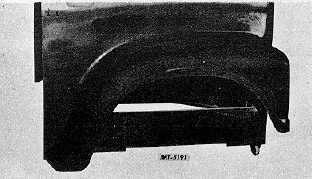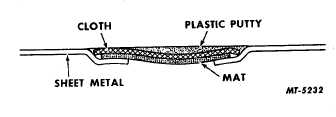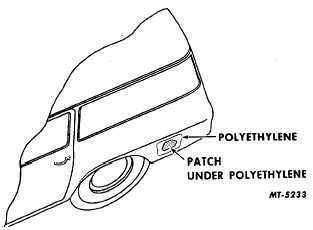|
| |
TRUCK SERVICE MANUAL
TM 5-4210-230-14&P-1
BODIES AND CABS
Fig. 13 Repaired Hood and Fender Assembly.
REPAIRING SHEET METAL WITH FIBERGLASS
Small Holes (Under 3" Diameter):
Repair on sheet metal as well as fiberglass can be
made with the fiberglass reinforced plastic repair kit. It
can be used to repair torn holes, rust holes and
damaged surfaces which are difficult to refinish with the
usual sheet metal repair procedures.
1.
Clean metal to bare surface with No. 16 or 24 grit
sandpaper approximately 6" beyond area being
repaired.
2. Indent area being repaired about 2" beyond damaged
area.
3.
Cut a piece of mat about 1" larger than the surface
being repaired, then a piece of cloth (two or three
pieces of mat may be used to fill the indented area).
4.
Brush the resin mixture on the damaged area and
then saturate the layers of mat and cloth being used.
Allow the resin mixture to get tacky.
5.
Apply the mat and cloth patches, pressing the
laminations down tightly with a sheet of polyethylene
to produce a tight bond. (The cloth patch is installed
last). See Fig. 14.
Fig. 14
6. Allow material to cure.
7.
Sand and file surface after patches have cured.
8.
Mix up a plastic putty mixture and fill low areas.
9. Allow the putty to cure, then sand smooth.
Large Holes (Over 3" Diameter):
1.
Clean metal to bare surface and dent in surface
being repaired as in items 1 and 2 for "Small Holes".
2.
On a piece of polyethylene position a piece of cloth
larger than hole being repaired. Saturate with resin
mixture. Apply two layers of mat (Fig. 4) saturating
both with the resin mixture. Now place the entire
patch on the prepared surface and press on to metal.
See Fig. 15. Allow the patch to cure, then peel off
polyethylene.
Fig. 15
3.
In the resulting low spots, apply plastic putty. Then
over the putty position another sheet of polyethylene
and squeeze well to remove all air. When putty has
cured, remove polyethylene and sand down to a
feather edge.
Dents:
1. Clean metal to bare surface.
2. Drill or punch 1/8" holes in the dent to assure a good
anchor for patch. See Fig. 16.
3. If the dent is over 1", cover dent with piece of cloth and
saturate with resin mixture. Allow to cure.
CTS-2408 Page 7
PRINTED IN UNITED STATES OF AMERICA
|



